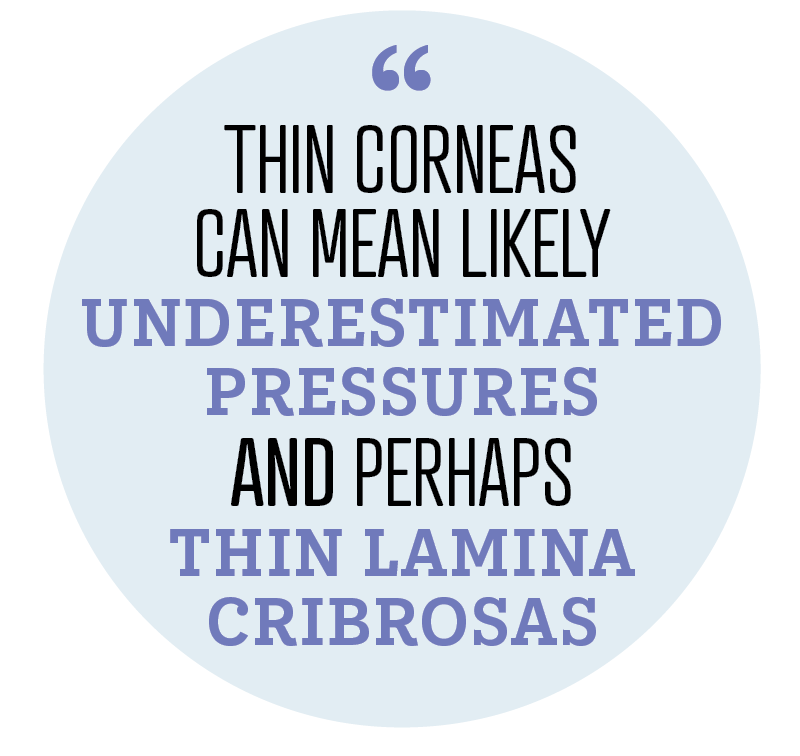- Therapeutic Cataract & Refractive
- Lens Technology
- Glasses
- Ptosis
- AMD
- COVID-19
- DME
- Ocular Surface Disease
- Optic Relief
- Geographic Atrophy
- Cornea
- Conjunctivitis
- LASIK
- Myopia
- Presbyopia
- Allergy
- Nutrition
- Pediatrics
- Retina
- Cataract
- Contact Lenses
- Lid and Lash
- Dry Eye
- Glaucoma
- Refractive Surgery
- Comanagement
- Blepharitis
- OCT
- Patient Care
- Diabetic Eye Disease
- Technology
Pachymetry holds a place in patient care
Don’t forget to look at a patient’s optic nerve through a dilated pupil.
Thin corneas can mean likely underestimated pressures and perhaps thin lamina cribrosas. (Adobe Stock / Alessandro Grandini)

We seem to be on track to have a paradigm shift in the arena of glaucoma every generation or so. I must admit that during my lectures I enjoy pushing back at the audience by reminding them that new technology coming out does not mean we can forget about aspects of glaucoma diagnosis and management such as actually looking at the optic nerve through a dilated pupil with our own eyes. I have a course titled, “Don’t Get Fooled: When the OCT Goofs,” in which I admittedly sound like an old, holdout curmudgeon as I go through a grand rounds format of cases in which the optical coherence tomography (OCT) studies were fallacious enough to throw the clinician off the trail of a correct diagnosis.
So at the risk of this middle-aged optometrist sounding like a curmudgeon yet again, allow me to wax poetic on the topic of pachymetry and its importance for a few lines. Buckle up. This month’s column is going to be an exciting one.
A 74-year-old Black male presented as a referral from a community health clinic for a diabetic eye exam. I admittedly don’t particularly care for the phrase “diabetic eye exam,” as if I’m not going to dilate a new patient’s eyes and examine their retinas regardless of the status of their blood glucose level. I digress. His medical history was remarkable for type 2 diabetes mellitus with a most recent A1c of 6.8, systemic hypertension, and high hypercholesterolemia. His current medications included metformin, lisinopril, and atorvastatin. He was allergic to penicillin and bees. He was unsure of his family history, having lost his parents many years ago. He believed his cataract surgeries had taken place about a decade ago, and had no other ophthalmic surgical history.

Entering distance unaided visual acuities were 20/25-2 in the right eye and 20/30 in the left eye. Confrontation visual fields were full and intact for each eye, and pupils were equal and unremarkably reactive to light for each with no afferent pupillary defect for either eye. Extraocular muscle function was full and intact for each eye. The patient refracted to 20/20 in each eye by means of a low hyperopic astigmatic correction. Slit lamp examination of his anterior segments showed unremarkable lids and lashes, quiet conjunctivae with scattered melanosis on the bulbar conjunctivae, clear and quiet corneas, angles open to grade 4 nasally and temporally by means of the Van Herick method, quiet anterior chambers, and unremarkable irises. His IOPs measured by means of rebound tonometry were 23 mmHg in the right eye and 24 mmHg in the left eye. He was dilated with 1% tropicamide and 2.5% phenylephrine in each eye. Dilated fundus examination showed unremarkable retinas with no diabetic or hypertensive retinopathy in either eye, bilateral complete posterior vitreous detachments, and optic nerves with cup-to-disc ratios of around 0.5 vertically with no appreciable retinal nerve fiber layer defects by means of red-free examination.
I shared the good news with the patient that he had no diabetic retinopathy in either eye. I then obtained fundus photos and invited him back in a couple of weeks in the morning for some specific glaucoma testing.
At his follow-up visit, visual acuities were essentially unchanged, and IOPs by means of Goldmann applanation tonometry were 24 mmHg in each eye. Gonioscopy showed angles open to the ciliary body with mild pigment and a flat iris approach in all 4 quadrants in each eye. Spectral domain OCT studies showed essentially clear retinal nerve fiber layers in each eye with the ganglion cell complex showing some very faint, splotchy areas flagged as being thin. His visual field studies were unremarkable for each eye. Pachymetry revealed central corneal thickness values of 468 micrometers in the right eye and 470 micrometers in the left eye. Now that’s thin. I thought about it for a few seconds before realizing that this borderline glaucoma patient’s eyes were begging to be treated, and for 1 reason: the low pachymetry values! There exists no perfectly linear relationship between central corneal thickness and IOP. Thin corneas can mean likely underestimated pressures and perhaps thin lamina cribrosas (the meshwork through which the optic nerve fibers fenestrate as they exit the globe).
I gave my patient a sample of a prostaglandin analog and invited him back in a month for an IOP check.

So there! I decided to treat with something as mundane as it gets: pachymetry. End of the story? Not quite. The patient returned with IOPs of 16 mmHg in each eye and with a story for me. He had called his sister and reported learning that his father passed away with poor vision and had to take many eye drops. So now I must admit that he is being treated based on pachymetry values as well as family history.

